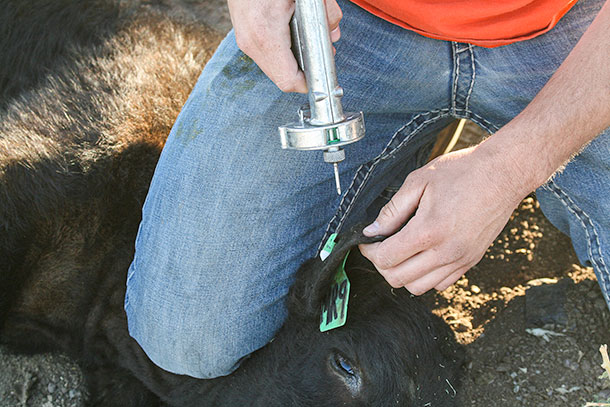Beef implants are inserted under the skin of the outer ear in inedible tissue.
Growth-promoting implants have been used in the beef cattle industry for decades. They serve to increase muscle accretion and market weight by increasing both daily gain and feed efficiency.
Research studying cattle growth and consumer safety is extensive. Prior to approval by the Food and Drug Administration, implants must meet stringent requirements in order to be deemed safe for consumers and animals. There cannot be implant residue in any edible tissues, and they cannot be toxic to cattle or cause mutations or cancerous growths.
Food safety
Implants have a minuscule effect on hormone content of beef. The estrogenic activity in a 3-ounce serving of steak from an implanted animal, versus a non-implanted animal, is 1.9 nanograms (ng) and 1.3 ng, respectively. To put this in perspective, a 3-ounce serving of broccoli contains 94,000 ng, and a 3-ounce black-bean burger contains 1.67 million ng of estrogenic activity. Hormones in beef from implanted cattle are minute relative to what occurs naturally in some other foods. Additionally, implanted beef is not only safe for human consumption but is also economical and environmentally beneficial because it produces significantly more beef while using similar resources.
Application
Beef implants consist of small pellets containing active compounds. They are placed under the skin of the outer ear, in inedible tissue. The pellets slowly release over time, with active ingredients being depleted in 80 to 200 days. Active ingredients include estradiol, progesterone, zeranol, testosterone and/or trenbolone acetate (TBA). Estradiol, progesterone and zeranol are estrogenic hormones, whereas testosterone and TBA are androgenic. In general, estrogenic compounds have the most benefit when applied to steers, and the same is true of androgenic compounds with heifers. This provides a growth hormone that does not naturally occur within the given gender. View a list of available implant brands and applications.
Implants enhance muscle synthesis and increase nutrient requirements of cattle. This increased demand for protein and energy typically results in increased feed intake and additional days on feed to reach the same level of marbling. Implants are generally classified by their potency. Low-potency implants contain estradiol and progesterone, or zeranol. Moderate-potency implants contain TBA in combination with one or more estrogenic hormones. High-potency implants contain up to 200 milligrams of TBA in combination with one or more estrogenic hormones.
Different implant brands will vary in their potency and duration of payout. A proper implanting strategy involves increasing potency with each subsequent implant and not allowing the final implant to “expire” before cattle are marketed. Higher-potency implants should be coupled with increased ration energy content. Protein intake is also important to support muscle growth. Rations should target a minimum of 12%–13% crude protein with medium- and high-potency implants. There are numerous gender-specific implants or implant strategies available across all sectors of the beef industry, from nursing calves to stocker, grower and finishing programs.
Nursing steers, as well as heifers that will not be used as replacements, should be considered for low-potency implants. Implanting calves will improve daily gains by about 5%. Depending on implant brand and time of first implant, calves may need to be reimplanted after 120 days. A secondary low-potency, short-duration implant in nursing calves will increase weaning weight another 1 to 8 pounds. If using a longer-duration implant, a secondary implant will not be needed. Calves nursing heavier-milking cows and calves with access to creep feed will have a greater response to implants. Producers contemplating selling calves into natural or non-hormone treated cattle (NHTC) programs need to consider if these premiums outweigh the additional pounds acquired with an implant.
Implanting stocker calves will increase their daily gains by 10%–20%. In this phase of production, steers will typically have a greater growth response to low- and moderate-potency implants than heifers. Match grazing time with the effective days of the implant to avoid reimplanting while on grass. If pasture quality declines and no additional supplementation is provided, a secondary implant in the stocker phase may not be advisable.
Most feeder cattle will receive at least one implant during the finishing phase of production. Response to implants is greater in the finishing phase compared to nursing and stocker calves. Increased average daily gains of 15%-20%, improved feed efficiencies of 6%-14%, increased ribeye areas of 3%-4% and heavier carcass weights are typical. The greatest performance in feedlot cattle is achieved with moderate- and high-potency implants. If cattle entering the feedlot have not been implanted or have an unknown implant history, a moderate-potency implant followed by one with a high potency may be advised.
Beef implants are an impressive technology that can improve cattle performance across all phases of the beef industry. Understanding the various production phases, dietary requirements and physiological differences among cattle can help determine the correct implant program to maximize returns, as well as to produce the best-possible product for consumers.
SOURCE: James Gaspers for Progressive Cattle, James Gaspers is a beef nutritionist at Hubbard Feeds.
PHOTO: Paul Marchant.








